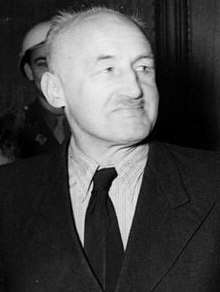Der Giftpilz
 Cover illustration. The text is in the Sütterlin script. | |
| Author | Ernst Hiemer |
|---|---|
| Original title | Der Giftpilz |
| Illustrator | Philipp Rupprecht (Fips) |
| Country | Germany |
| Language | German |
| Genre | Children's literature, Anti-Semitism |
| Publisher | Julius Streicher |
Publication date | 1938 |
| Media type | |
| Pages | 56 |
| 833.912 | |
Der Giftpilz is a children's book published by Julius Streicher in 1938.[1] The title is German for "the toadstool" or "the poisonous mushroom".[1] The book was intended as anti-Semitic propaganda. The text is by Ernst Hiemer, with illustrations by Philipp Rupprecht (also known as Fips); the title alludes to how, just as it is difficult to tell a poisonous mushroom from an edible mushroom, it is difficult to tell a Jew apart from a Gentile. The book wants to "warn" German children about the dangers allegedly posed by Jews to them personally, and to German society in general.
In some instances, it is implied that Jews will try to molest children; one little girl escapes a Jew offering her sweets only when her brother calls the police,[2] and when Inge's mother sends her to a Jewish doctor, despite Inge's protests of what she learned in the League of German Girls, Inge barely escapes.[3] Communism is portrayed as being led by Jews who wish to sacrifice Germany to Russia's good – this being put in the mouth of a former Communist, whose loyalty to Germany brought him to the Nazi party.[4] Jews are portrayed as abusing their German servants.[5] In addition, the book warns of Jews in various occupations – Jewish businessmen,[6] lawyers,[7] tradesmen,[8] and kosher butchers, who, in one chapter, are described torturing an animal to death.[9] The same chapter also accuses the Jews of kidnapping Christian children to use their blood in matzohs (a common variant of the blood libel).[9] One of the final chapters blames the Jews for the death of Jesus, who is called the greatest enemy of the Jews of all time.[10]
Anti-Semitism
There is an entire chapter containing numerous false quotations from the Talmud.[11] The book claims that the Talmud forbids Jews to do manual labour, and that Jews are only permitted to engage in trade, and that non-Jews are meant to be slaves. The chapter further states that Talmudic law allows Jews to cheat non-Jews, and asks Jews to enslave the non-Jewish population. It was sometimes used in schools.[1]

A copy of the book is on display at the U.S. Holocaust Memorial Museum in Washington, D. C. An English-language translation of the book was produced by U.S. neo-Nazi activist Gary Lauck, and thereafter marketed on his Web site for $10. Lauck also produced an Estonian language translation in 2007, and claims to be working on translations into many other languages.[12] The Estonian Internal Security Service have investigated the case under the section of Estonian penal code criminalizing incitement to social hatred, but concluded that it is unlikely to have the jurisdiction or means to prosecute the author, as under American law, websites are covered by the First Amendment to the United States Constitution.[13]
See also
References
- 1 2 3 "Der Giftpilz"
- ↑ "The Experience of Hans and Else with a Strange Man"
- ↑ "Inge’s Visit to a Jewish Doctor"
- ↑ "How Worker Hartmann Became a National-Socialist"
- ↑ "How the Jew Treats His Domestic Help"
- ↑ "How a German Peasant Was Driven from House and Farm"
- ↑ "How Two Women Were Tricked by Jewish Lawyers"
- ↑ "How Jewish Traders Cheat"
- 1 2 "How Jews Torment Animals"
- ↑ "What Christ Said about the Jews"
- ↑ "What is the Talmud?"
- ↑ Lauck's official site.
- ↑ "Juute vaenav raamat tõlgiti eesti keelde" [An adversary's book was translated into Estonian] (in Estonian). Postimees. June 20, 2007. Retrieved 15 April 2018.